Identification of Key Drivers of Land Surface Temperature Within the Local Climate Zone Framework
Abstract
1. Introduction
2. Materials and Methods
2.1. Research Area and LCZ Classification
2.2. LST Calculation and Accuracy Assessment
2.3. Explanatory Variables
2.3.1. Vegetation Characteristics Indices
2.3.2. Urbanization Indices
2.3.3. Climatic Indices
2.3.4. Tasseled Cap Transformation Indices
2.3.5. Landscape Indices
2.4. Statistical Analysis
3. Results
3.1. Variation of LST in Different LCZs
3.2. Differences in Driving Factors Across Different LCZs
3.3. Spearman Correlation Analysis
3.4. Relative Importance of Factors
3.5. Partial Dependence Analysis of Key Driving Factors
4. Discussion
4.1. The LST Under Different LCZs
4.2. Driving Factors of LST
4.3. Implications for Future Urban Planning and Management
4.4. Limitations and Future Prospects
5. Conclusions
Author Contributions
Funding
Data Availability Statement
Conflicts of Interest
Appendix A
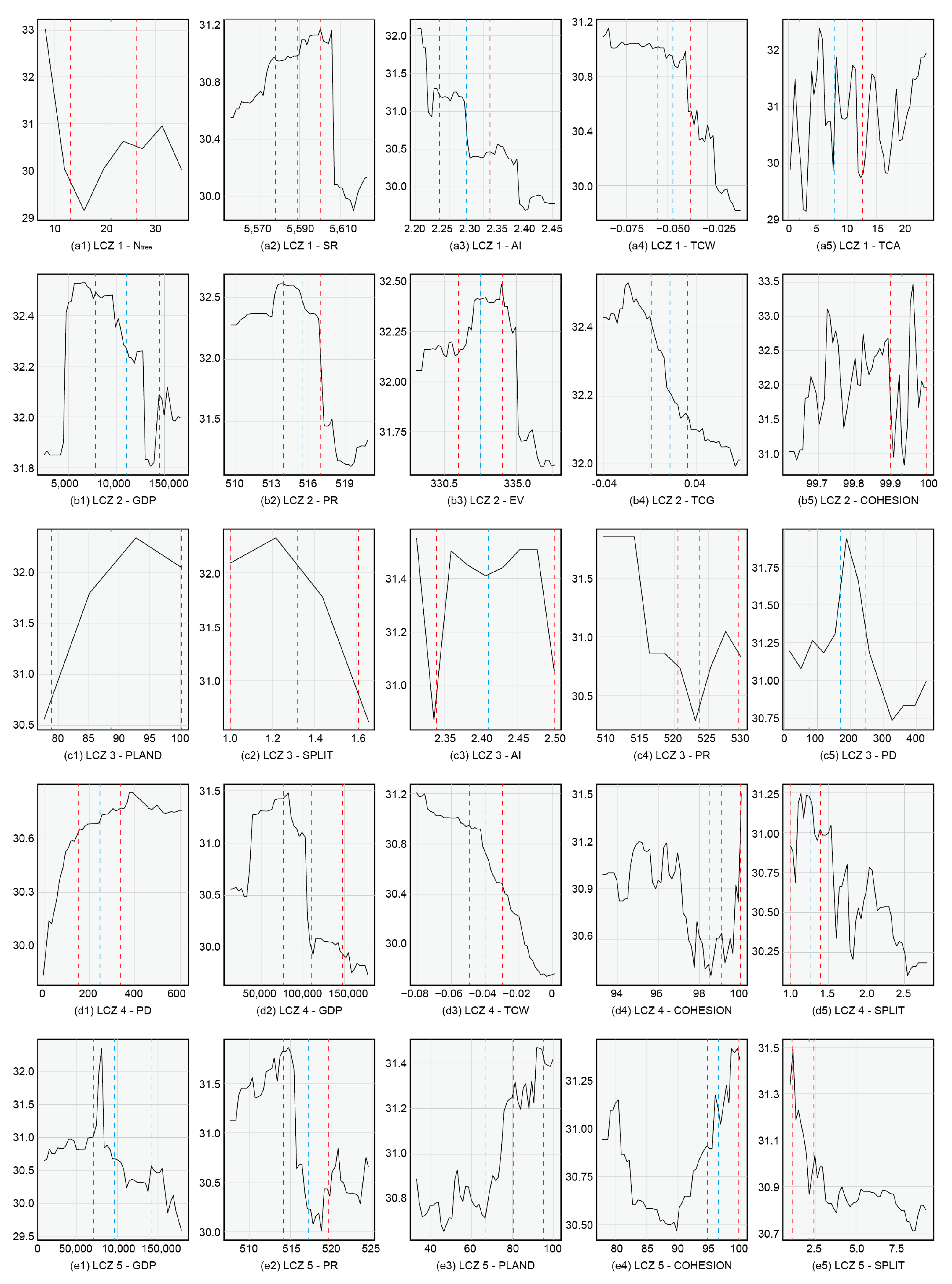


References
- Kim, S.W.; Brown, R.D. Urban Heat Island (UHI) Intensity and Magnitude Estimations: A Systematic Literature Review. Sci. Total Environ. 2021, 779, 146389. [Google Scholar] [CrossRef] [PubMed]
- Meng, Q.; Zhang, L.; Sun, Z.; Meng, F.; Wang, L.; Sun, Y. Characterizing Spatial and Temporal Trends of Surface Urban Heat Island Effect in an Urban Main Built-up Area: A 12-Year Case Study in Beijing, China. Remote Sens. Environ. 2018, 204, 826–837. [Google Scholar] [CrossRef]
- Shi, L.; Ling, F.; Foody, G.M.; Yang, Z.; Liu, X.; Du, Y. Seasonal SUHI Analysis Using Local Climate Zone Classification: A Case Study of Wuhan, China. Int. J. Environ. Res. Public Health 2021, 18, 7242. [Google Scholar] [CrossRef]
- Tao, F.; Hu, Y.; Tang, G.; Zhou, T. Long-Term Evolution of the SUHI Footprint and Urban Expansion Based on a Temperature Attenuation Curve in the Yangtze River Delta Urban Agglomeration. Sustainability 2021, 13, 8530. [Google Scholar] [CrossRef]
- Miky, Y.; Al Shouny, A.; Abdallah, A. Studying the Impact of Urban Management Strategies and Spatiotemporal Dynamics of LULC on Land Surface Temperature and SUHI Formation in Jeddah, Saudi Arabia. Sustainability 2023, 15, 15316. [Google Scholar] [CrossRef]
- Halder, B.; Bandyopadhyay, J.; Banik, P. Monitoring the Effect of Urban Development on Urban Heat Island Based on Remote Sensing and Geo-Spatial Approach in Kolkata and Adjacent Areas, India. Sustain. Cities Soc. 2021, 74, 103186. [Google Scholar] [CrossRef]
- Yuan, S.; Ren, Z.; Shan, X.; Deng, Q.; Zhou, Z. Seasonal Different Effects of Land Cover on Urban Heat Island in Wuhan’s Metropolitan Area. Urban Clim. 2023, 49, 101547. [Google Scholar] [CrossRef]
- Marando, F.; Heris, M.P.; Zulian, G.; Udías, A.; Mentaschi, L.; Chrysoulakis, N.; Parastatidis, D.; Maes, J. Urban Heat Island Mitigation by Green Infrastructure in European Functional Urban Areas. Sustain. Cities Soc. 2022, 77, 103564. [Google Scholar] [CrossRef]
- Xie, J.; Zhou, S.; Chung, L.C.H.; Chan, T.O. Evaluating Land-Surface Warming and Cooling Environments across Urban–Rural Local Climate Zone Gradients in Subtropical Megacities. Build. Environ. 2024, 251, 111232. [Google Scholar] [CrossRef]
- Geng, S.; Yang, L.; Sun, Z.; Wang, Z.; Qian, J.; Jiang, C.; Wen, M. Spatiotemporal Patterns and Driving Forces of Remotely Sensed Urban Agglomeration Heat Islands in South China. Sci. Total Environ. 2021, 800, 149499. [Google Scholar] [CrossRef]
- Jia, X.; Han, H.; Feng, Y.; Song, P.; He, R.; Liu, Y.; Wang, P.; Zhang, K.; Du, C.; Ge, S.; et al. Scale-Dependent and Driving Relationships between Spatial Features and Carbon Storage and Sequestration in an Urban Park of Zhengzhou, China. Sci. Total Environ. 2023, 894, 164916. [Google Scholar] [CrossRef] [PubMed]
- Zhao, C.; Zhu, H.; Zhang, S.; Jin, Z.; Zhang, Y.; Wang, Y.; Shi, Y.; Jiang, J.; Chen, X.; Liu, M. Long–term Trends in Surface Thermal Environment and Its Potential Drivers along the Urban Development Gradients in Rapidly Urbanizing Regions of China. Sustain. Cities Soc. 2024, 105, 105324. [Google Scholar] [CrossRef]
- Mohammad Harmay, N.S.; Kim, D.; Choi, M. Urban Heat Island Associated with Land Use/Land Cover and Climate Variations in Melbourne, Australia. Sustain. Cities Soc. 2021, 69, 102861. [Google Scholar] [CrossRef]
- Demuzere, M.; Kittner, J.; Bechtel, B. LCZ Generator: A Web Application to Create Local Climate Zone Maps. Front. Environ. Sci. 2021, 9, 637455. [Google Scholar] [CrossRef]
- Chen, Y.; Yang, J.; Yu, W.; Ren, J.; Xiao, X.; Xia, J.C. Relationship between Urban Spatial Form and Seasonal Land Surface Temperature under Different Grid Scales. Sustain. Cities Soc. 2023, 89, 104374. [Google Scholar] [CrossRef]
- Zeng, P.; Sun, F.; Liu, Y.; Tian, T.; Wu, J.; Dong, Q.; Peng, S.; Che, Y. The Influence of the Landscape Pattern on the Urban Land Surface Temperature Varies with the Ratio of Land Components: Insights from 2D/3D Building/Vegetation Metrics. Sustain. Cities Soc. 2022, 78, 103599. [Google Scholar] [CrossRef]
- Mushore, T.D.; Dube, T.; Manjowe, M.; Gumindoga, W.; Chemura, A.; Rousta, I.; Odindi, J.; Mutanga, O. Remotely Sensed Retrieval of Local Climate Zones and Their Linkages to Land Surface Temperature in Harare Metropolitan City, Zimbabwe. Urban Clim. 2019, 27, 259–271. [Google Scholar] [CrossRef]
- Feizizadeh, B.; Blaschke, T.; Nazmfar, H.; Akbari, E.; Kohbanani, H.R. Monitoring Land Surface Temperature Relationship to Land Use/Land Cover from Satellite Imagery in Maraqeh County, Iran. J. Environ. Plan. Manag. 2013, 56, 1290–1315. [Google Scholar] [CrossRef]
- Li, Z.-L.; Tang, B.-H.; Wu, H.; Ren, H.; Yan, G.; Wan, Z.; Trigo, I.F.; Sobrino, J.A. Satellite-Derived Land Surface Temperature: Current Status and Perspectives. Remote Sens. Environ. 2013, 131, 14–37. [Google Scholar] [CrossRef]
- Tatem, A.J. WorldPop, Open Data for Spatial Demography. Sci. Data 2017, 4, 170004. [Google Scholar] [CrossRef]
- Elvidge, C.D.; Zhizhin, M.; Baugh, K.; Hsu, F.-C. Automatic Boat Identification System for VIIRS Low Light Imaging Data. Remote Sens. 2015, 7, 3020–3036. [Google Scholar] [CrossRef]
- Hsu, F.-C.; Elvidge, C.D.; Baugh, K.; Zhizhin, M.; Ghosh, T.; Kroodsma, D.; Susanto, A.; Budy, W.; Riyanto, M.; Nurzeha, R.; et al. Cross-Matching VIIRS Boat Detections with Vessel Monitoring System Tracks in Indonesia. Remote Sens. 2019, 11, 995. [Google Scholar] [CrossRef]
- Zhao, Z.; Tang, X.; Wang, C.; Cheng, G.; Ma, C.; Wang, H.; Sun, B. Analysis of the Spatial and Temporal Evolution of the GDP in Henan Province Based on Nighttime Light Data. Remote Sens. 2023, 15, 716. [Google Scholar] [CrossRef]
- Open Street Map. Available online: https://www.openstreetmap.org (accessed on 5 October 2023).
- Wu, W.-B.; Ma, J.; Banzhaf, E.; Meadows, M.E.; Yu, Z.-W.; Guo, F.-X.; Sengupta, D.; Cai, X.-X.; Zhao, B. A First Chinese Building Height Estimate at 10 m Resolution (CNBH-10 m) Using Multi-Source Earth Observations and Machine Learning. Remote Sens. Environ. 2023, 291, 113578. [Google Scholar] [CrossRef]
- Peng, S.; Ding, Y.; Liu, W.; Li, Z. 1km Monthly Temperature and Precipitation Dataset for China from 1901 to 2017. Earth Syst. Sci. Data 2019, 11, 1931–1946. [Google Scholar] [CrossRef]
- Kusari, P.; Kusari, S.; Spiteller, M.; Kayser, O. Endophytic Fungi Harbored in Cannabis Sativa L.: Diversity and Potential as Biocontrol Agents against Host Plant-Specific Phytopathogens. Fungal Divers. 2013, 60, 137–151. [Google Scholar] [CrossRef]
- Feng, Y.; Zhang, K.; Li, A.; Zhang, Y.; Wang, K.; Guo, N.; Wan, H.Y.; Tan, X.; Dong, N.; Xu, X.; et al. Spatial and Seasonal Variation and the Driving Mechanism of the Thermal Effects of Urban Park Green Spaces in Zhengzhou, China. Land 2024, 13, 1474. [Google Scholar] [CrossRef]
- Huo, X.; Ren, C.; Wang, D.; Wu, R.; Wang, Y.; Li, Z.; Huang, D.; Qi, H. Microbial Community Assembly and Its Influencing Factors of Secondary Forests in Qinling Mountains. Soil Biol. Biochem. 2023, 184, 109075. [Google Scholar] [CrossRef]
- Mahood, A.L.; Balch, J.K. Repeated Fires Reduce Plant Diversity in Low-Elevation Wyoming Big Sagebrush Ecosystems (1984–2014). Ecosphere 2019, 10, e02591. [Google Scholar] [CrossRef]
- Xu, H.; Wang, Y.; Guan, H.; Shi, T.; Hu, X. Detecting Ecological Changes with a Remote Sensing Based Ecological Index (RSEI) Produced Time Series and Change Vector Analysis. Remote Sens. 2019, 11, 2345. [Google Scholar] [CrossRef]
- Apley, D.W.; Zhu, J. Visualizing the Effects of Predictor Variables in Black Box Supervised Learning Models. J. R. Stat. Soc. Ser. B Stat. Methodol. 2020, 82, 1059–1086. [Google Scholar] [CrossRef]
- Probst, P.; Wright, M.N.; Boulesteix, A.-L. Hyperparameters and Tuning Strategies for Random Forest. WIREs Data Min. Knowl. Discov. 2019, 9, e1301. [Google Scholar] [CrossRef]
- Grachev, A.A.; Fairall, C.W.; Blomquist, B.W.; Fernando, H.J.S.; Leo, L.S.; Otárola-Bustos, S.F.; Wilczak, J.M.; McCaffrey, K.L. On the Surface Energy Balance Closure at Different Temporal Scales. Agric. For. Meteorol. 2020, 281, 107823. [Google Scholar] [CrossRef]
- Shen, P.; Zhao, S.; Ma, Y. Perturbation of Urbanization to Earth’s Surface Energy Balance. J. Geophys. Res. Atmos. 2021, 126, e2020JD033521. [Google Scholar] [CrossRef]
- Chen, H.; Jeanne Huang, J.; Liang, H.; Wang, W.; Li, H.; Wei, Y.; Jiang, A.Z.; Zhang, P. Can Evaporation from Urban Impervious Surfaces Be Ignored? J. Hydrol. 2023, 616, 128582. [Google Scholar] [CrossRef]
- Feyisa, G.L.; Dons, K.; Meilby, H. Efficiency of Parks in Mitigating Urban Heat Island Effect: An Example from Addis Ababa. Landsc. Urban Plan. 2014, 123, 87–95. [Google Scholar] [CrossRef]
- Gunawardena, K.R.; Wells, M.J.; Kershaw, T. Utilising Green and Bluespace to Mitigate Urban Heat Island Intensity. Sci. Total Environ. 2017, 584, 1040–1055. [Google Scholar] [CrossRef]
- Yang, J.; Yang, Y.; Sun, D.; Jin, C.; Xiao, X. Influence of Urban Morphological Characteristics on Thermal Environment. Sustain. Cities Soc. 2021, 72, 103045. [Google Scholar] [CrossRef]
- Mushore, T.D.; Mutanga, O.; Odindi, J. Determining the Influence of Long Term Urban Growth on Surface Urban Heat Islands Using Local Climate Zones and Intensity Analysis Techniques. Remote Sens. 2022, 14, 2060. [Google Scholar] [CrossRef]
- Žgela, M.; Herceg-Bulić, I.; Lozuk, J.; Jureša, P. Linking Land Surface Temperature and Local Climate Zones in Nine Croatian Cities. Urban Clim. 2024, 54, 101842. [Google Scholar] [CrossRef]
- Zwolska, A.; Półrolniczak, M.; Kolendowicz, L. Urban Growth’s Implications on Land Surface Temperature in a Medium-Sized European City Based on LCZ Classification. Sci. Rep. 2024, 14, 8308. [Google Scholar]
- Sun, Y.; Gao, C.; Li, J.; Wang, R.; Liu, J. Evaluating Urban Heat Island Intensity and Its Associated Determinants of Towns and Cities Continuum in the Yangtze River Delta Urban Agglomerations. Sustain. Cities Soc. 2019, 50, 101659. [Google Scholar] [CrossRef]
- He, B.-J.; Ding, L.; Prasad, D. Enhancing Urban Ventilation Performance through the Development of Precinct Ventilation Zones: A Case Study Based on the Greater Sydney, Australia. Sustain. Cities Soc. 2019, 47, 101472. [Google Scholar] [CrossRef]
- Aflaki, A.; Mirnezhad, M.; Ghaffarianhoseini, A.; Ghaffarianhoseini, A.; Omrany, H.; Wang, Z.-H.; Akbari, H. Urban Heat Island Mitigation Strategies: A State-of-the-Art Review on Kuala Lumpur, Singapore and Hong Kong. Cities 2017, 62, 131–145. [Google Scholar] [CrossRef]
- Li, L.; Zhao, Z.; Wang, H.; Shen, L.; Liu, N.; He, B.-J. Variabilities of Land Surface Temperature and Frontal Area Index Based on Local Climate Zone. IEEE J. Sel. Top. Appl. Earth Obs. Remote Sens. 2022, 15, 2166–2174. [Google Scholar] [CrossRef]
- Wang, R.; Cai, M.; Ren, C.; Bechtel, B.; Xu, Y.; Ng, E. Detecting Multi-Temporal Land Cover Change and Land Surface Temperature in Pearl River Delta by Adopting Local Climate Zone. Urban Clim. 2019, 28, 100455. [Google Scholar] [CrossRef]
- Zhao, L.; Lee, X.; Smith, R.B.; Oleson, K. Strong Contributions of Local Background Climate to Urban Heat Islands. Nature 2014, 511, 216–219. [Google Scholar] [CrossRef]
- Luo, X.; Yang, J.; Sun, W.; He, B. Suitability of Human Settlements in Mountainous Areas from the Perspective of Ventilation: A Case Study of the Main Urban Area of Chongqing. J. Clean. Prod. 2021, 310, 127467. [Google Scholar] [CrossRef]
- Nasehi, S.; Yavari, A.; Salehi, E.; Emmanuel, R. Role of Local Climate Zone and Space Syntax on Land Surface Temperature (Case Study: Tehran). Urban Clim. 2022, 45, 101245. [Google Scholar] [CrossRef]
- Unal Cilek, M.; Cilek, A. Analyses of Land Surface Temperature (LST) Variability among Local Climate Zones (LCZs) Comparing Landsat-8 and ENVI-Met Model Data. Sustain. Cities Soc. 2021, 69, 102877. [Google Scholar] [CrossRef]
- Weng, Q.; Fu, P.; Gao, F. Generating Daily Land Surface Temperature at Landsat Resolution by Fusing Landsat and MODIS Data. Remote Sens. Environ. 2014, 145, 55–67. [Google Scholar] [CrossRef]
- Pelletier, M.C.; Gillett, D.J.; Hamilton, A.; Grayson, T.; Hansen, V.; Leppo, E.W.; Weisberg, S.B.; Borja, A. Adaptation and Application of Multivariate AMBI (M-AMBI) in US Coastal Waters. Ecol. Indic. 2018, 89, 818–827. [Google Scholar] [CrossRef]
- Zhou, W.; Wang, J.; Cadenasso, M.L. Effects of the Spatial Configuration of Trees on Urban Heat Mitigation: A Comparative Study. Remote Sens. Environ. 2017, 195, 1–12. [Google Scholar] [CrossRef]
- Huang, X.; Wang, Y. Investigating the Effects of 3D Urban Morphology on the Surface Urban Heat Island Effect in Urban Functional Zones by Using High-Resolution Remote Sensing Data: A Case Study of Wuhan, Central China. ISPRS J. Photogramm. Remote Sens. 2019, 152, 119–131. [Google Scholar] [CrossRef]
- Dewan, A.; Kiselev, G.; Botje, D.; Mahmud, G.I.; Bhuian, M.H.; Hassan, Q.K. Surface Urban Heat Island Intensity in Five Major Cities of Bangladesh: Patterns, Drivers and Trends. Sustain. Cities Soc. 2021, 71, 102926. [Google Scholar] [CrossRef]
- Coseo, P.; Larsen, L. How Factors of Land Use/Land Cover, Building Configuration, and Adjacent Heat Sources and Sinks Explain Urban Heat Islands in Chicago. Landsc. Urban Plan. 2014, 125, 117–129. [Google Scholar] [CrossRef]
- Song, J.; Chen, W.; Zhang, J.; Huang, K.; Hou, B.; Prishchepov, A.V. Effects of Building Density on Land Surface Temperature in China: Spatial Patterns and Determinants. Landsc. Urban Plan. 2020, 198, 103794. [Google Scholar] [CrossRef]
- Yang, J.; Jin, S.; Xiao, X.; Jin, C.; Xia, J.; Li, X.; Wang, S. Local Climate Zone Ventilation and Urban Land Surface Temperatures: Towards a Performance-Based and Wind-Sensitive Planning Proposal in Megacities. Sustain. Cities Soc. 2019, 47, 101487. [Google Scholar] [CrossRef]
- Chun, B.; Guldmann, J.-M. Spatial Statistical Analysis and Simulation of the Urban Heat Island in High-Density Central Cities. Landsc. Urban Plan. 2014, 125, 76–88. [Google Scholar] [CrossRef]
- Iwama, M.; Yoshinaka, T.; Nishioka, S.; Murakami, H. Reflectivity and Durability Assessment of Solar Heat-Blocking Pavement. In Proceedings of the 5th International Symposium on Asphalt Pavements & Environment (APE), Padua, Italy, 11–13 September 2019; Pasetto, M., Partl, M.N., Tebaldi, G., Eds.; Springer International Publishing: Cham, Germany, 2020; pp. 133–143. [Google Scholar]
- Ziaeemehr, B.; Jandaghian, Z.; Ge, H.; Lacasse, M.; Moore, T. Increasing Solar Reflectivity of Building Envelope Materials to Mitigate Urban Heat Islands: State-of-the-Art Review. Buildings 2023, 13, 2868. [Google Scholar] [CrossRef]
- Ambika, A.K.; Mishra, V. Observational Evidence of Irrigation Influence on Vegetation Health and Land Surface Temperature in India. Geophys. Res. Lett. 2019, 46, 13441–13451. [Google Scholar] [CrossRef]
- Chen, Y.; Shu, B.; Zhang, R.; Amani-Beni, M. LST Determination of Different Urban Growth Patterns: A Modeling Procedure to Identify the Dominant Spatial Metrics. Sustain. Cities Soc. 2023, 92, 104459. [Google Scholar] [CrossRef]
- Bokaie, M.; Zarkesh, M.K.; Arasteh, P.D.; Hosseini, A. Assessment of Urban Heat Island Based on the Relationship between Land Surface Temperature and Land Use/Land Cover in Tehran. Sustain. Cities Soc. 2016, 23, 94–104. [Google Scholar] [CrossRef]
- Yu, Q.; Acheampong, M.; Pu, R.; Landry, S.M.; Ji, W.; Dahigamuwa, T. Assessing Effects of Urban Vegetation Height on Land Surface Temperature in the City of Tampa, Florida, USA. Int. J. Appl. Earth Obs. Geoinf. 2018, 73, 712–720. [Google Scholar] [CrossRef]
- Hou, M.; Zhao, L.; Lin, A. Irrigation Cooling Effect on Local Temperatures in the North China Plain Based on an Improved Detection Method. Remote Sens. 2023, 15, 4571. [Google Scholar] [CrossRef]
- Imran, H.M.; Hossain, A.; Shammas, M.I.; Das, M.K.; Islam, M.R.; Rahman, K.; Almazroui, M. Land Surface Temperature and Human Thermal Comfort Responses to Land Use Dynamics in Chittagong City of Bangladesh. Geomat. Nat. Hazards Risk 2022, 13, 2283–2312. [Google Scholar] [CrossRef]
- Bechtel, B.; Alexander, P.J.; Böhner, J.; Ching, J.; Conrad, O.; Feddema, J.; Mills, G.; See, L.; Stewart, I. Mapping Local Climate Zones for a Worldwide Database of the Form and Function of Cities. ISPRS Int. J. Geo-Inf. 2015, 4, 199–219. [Google Scholar] [CrossRef]
- He, B.-J.; Fu, X.; Zhao, Z.; Chen, P.; Sharifi, A.; Li, H. Capability of LCZ Scheme to Differentiate Urban Thermal Environments in Five Megacities of China: Implications for Integrating LCZ System Into Heat-Resilient Planning and Design. IEEE J. Sel. Top. Appl. Earth Obs. Remote Sens. 2024, 17, 18800–18817. [Google Scholar] [CrossRef]
- Vaidya, M.; Keskar, R.; Kotharkar, R. Quantifying the Effect of Surrounding Spatial Heterogeneity on Land Surface Temperature Based on Local Climate Zones Using Mutual Information. Sustain. Cities Soc. 2024, 107, 105455. [Google Scholar] [CrossRef]
- Peng, J.; Jia, J.; Liu, Y.; Li, H.; Wu, J. Seasonal Contrast of the Dominant Factors for Spatial Distribution of Land Surface Temperature in Urban Areas. Remote Sens. Environ. 2018, 215, 255–267. [Google Scholar] [CrossRef]
73. Disclaimer/Publisher’s Note: The statements, opinions and data contained in all publications are solely those of the individual author(s) and contributor(s) and not of MDPI and/or the editor(s). MDPI and/or the editor(s) disclaim responsibility for any injury to people or property resulting from any ideas, methods, instructions or products referred to in the content. |

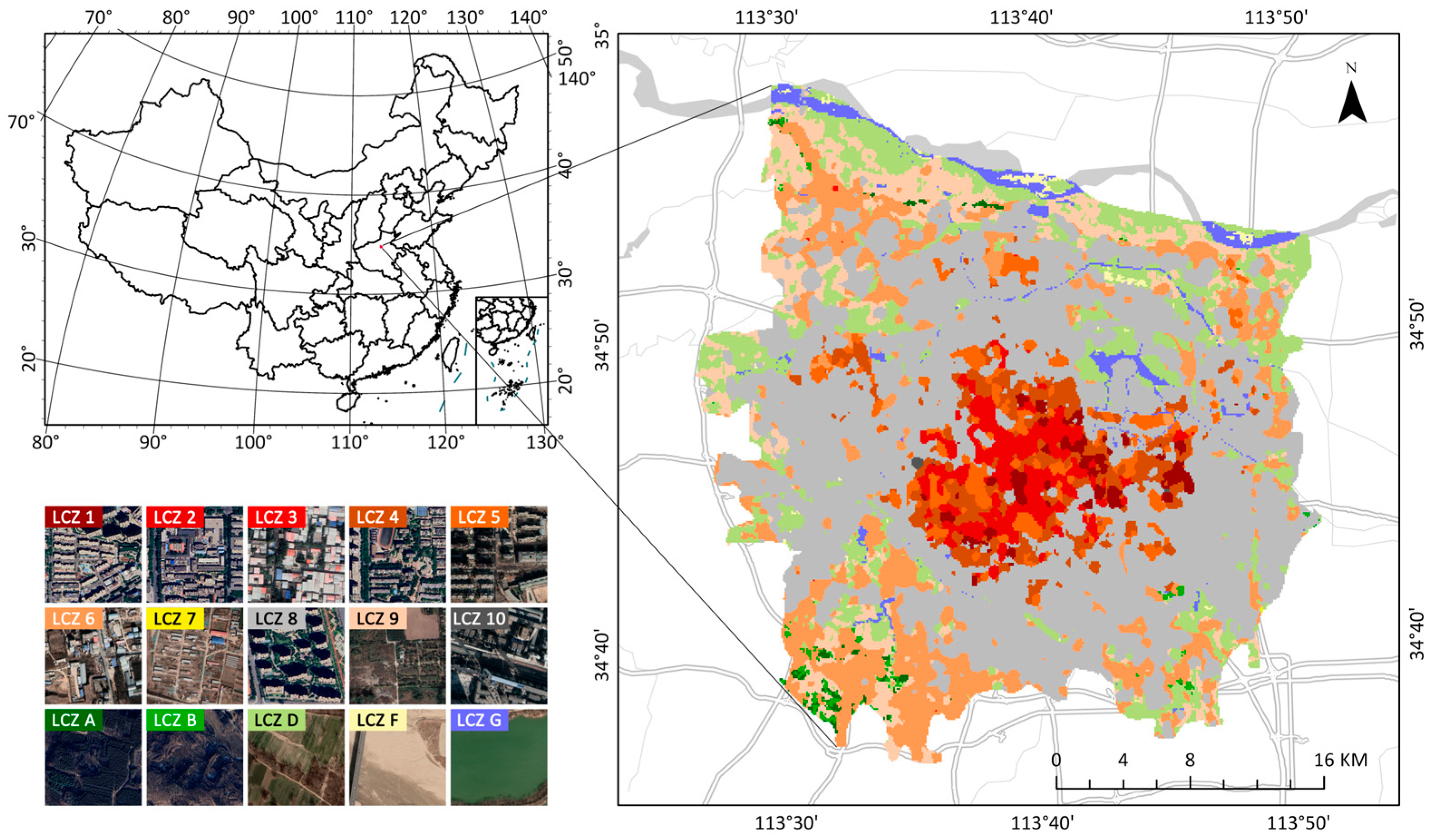
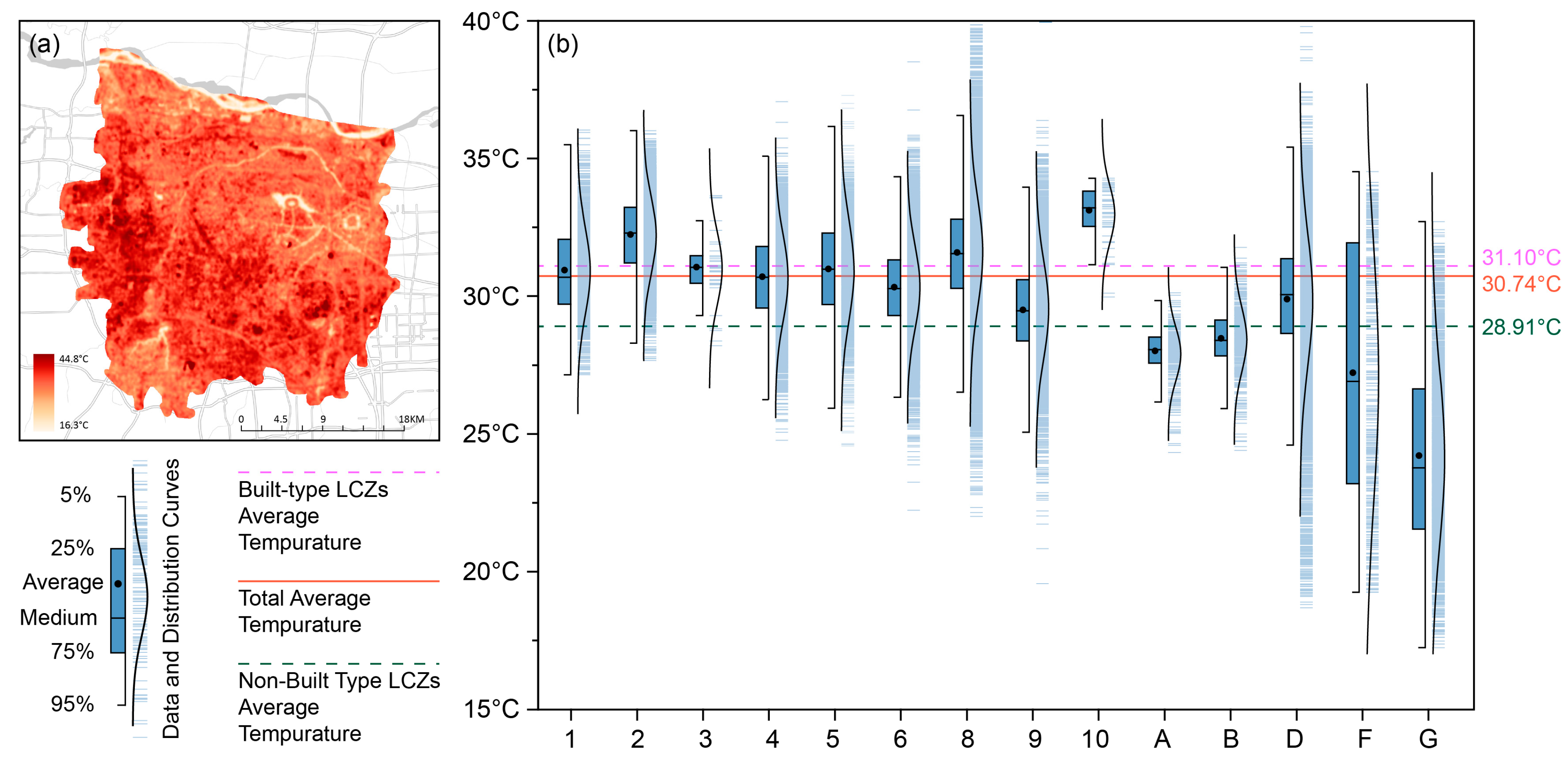
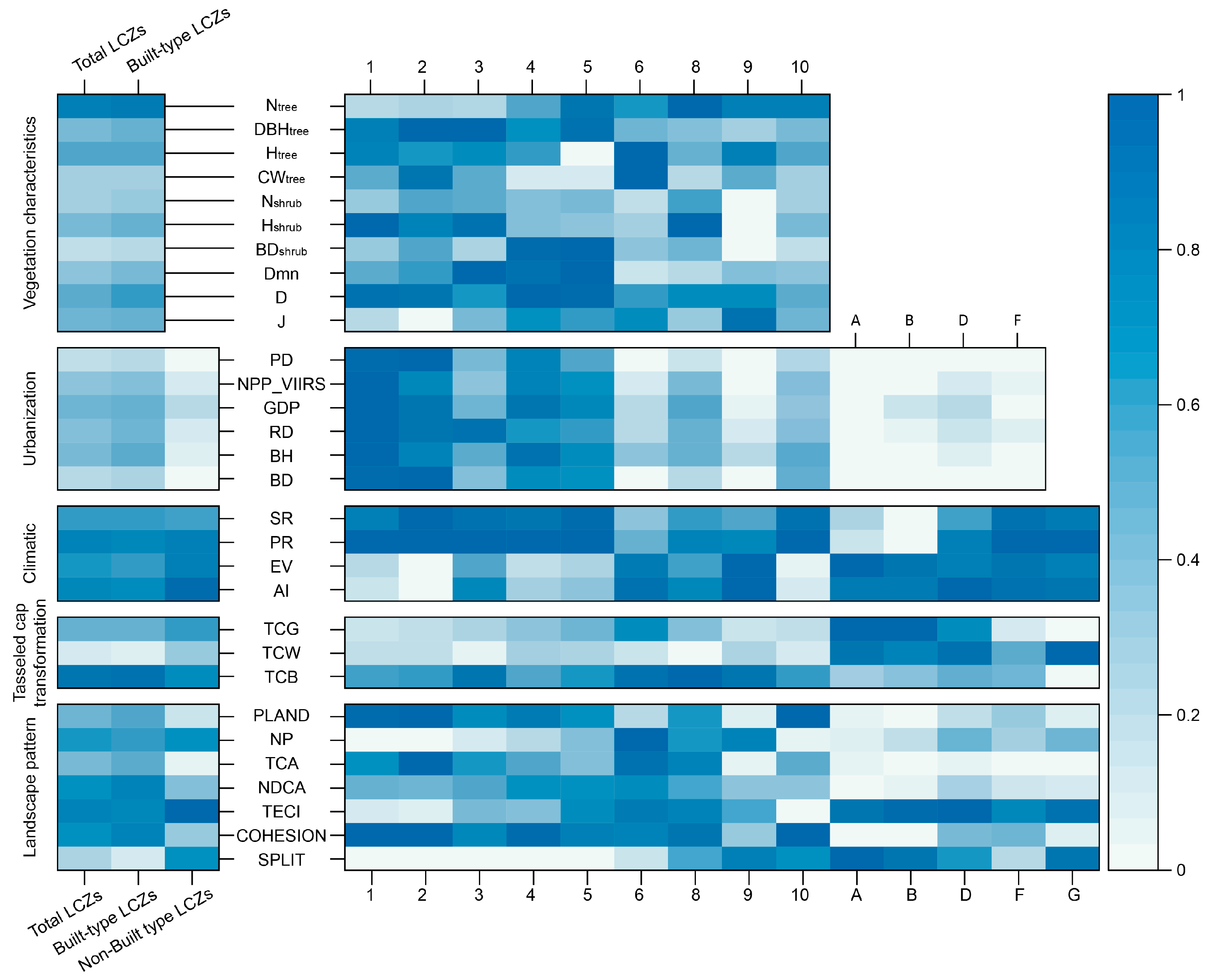


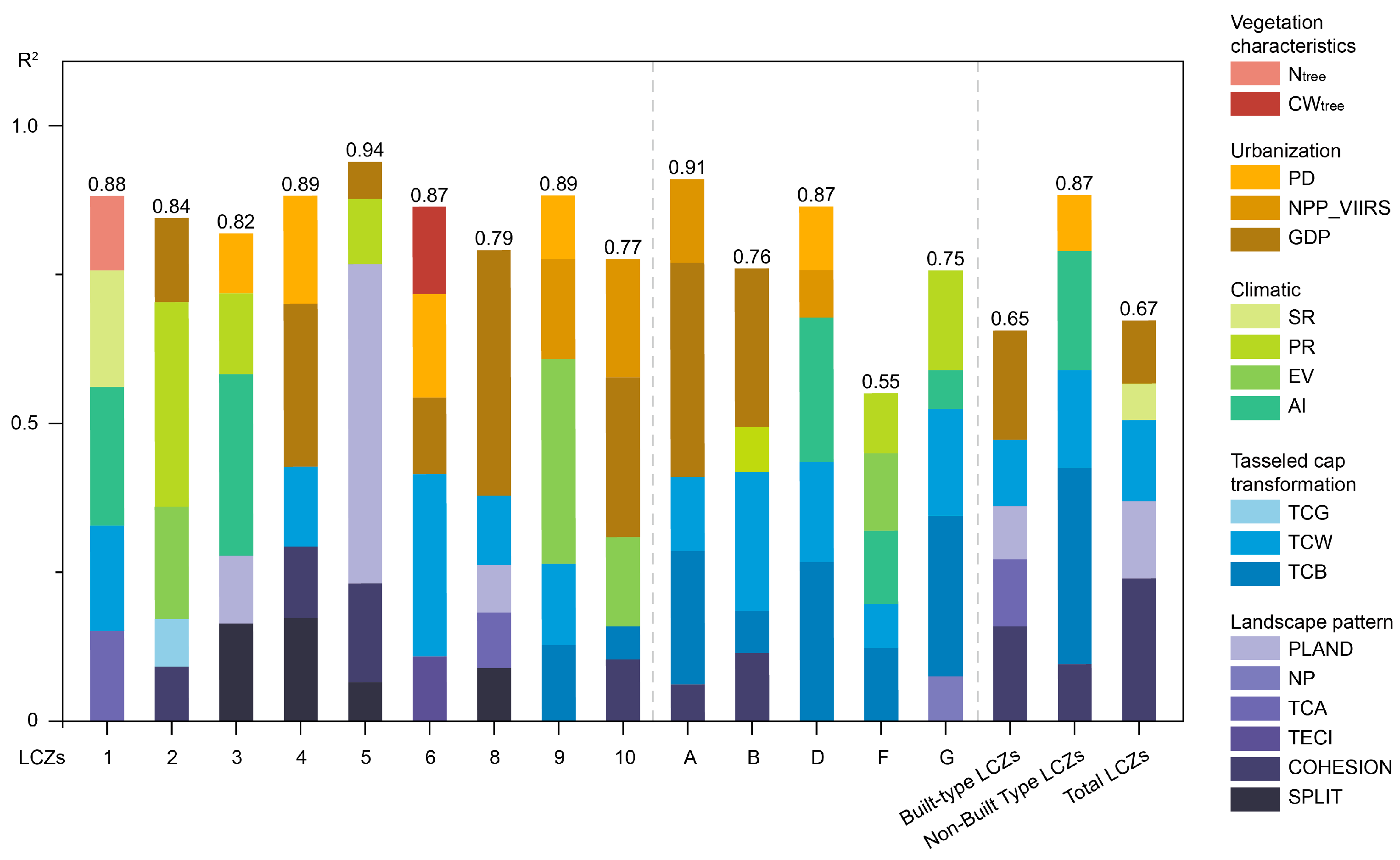

| LCZ | Definitions | Area (km2) | |
|---|---|---|---|
| Built type | 1 | Compact highrise | 14.23 |
| 2 | Compact midrise | 39.1 | |
| 3 | Compact lowrise | 0.66 | |
| 4 | Open highrise | 51.04 | |
| 5 | Open midrise | 36.38 | |
| 6 | Open lowrise | 144.97 | |
| 7 | Lightweight lowrise | 0.06 | |
| 8 | Large lowrise | 483.59 | |
| 9 | Sparsely built | 81.7 | |
| 10 | Heavy industry | 0.96 | |
| Non-built type | A | Dense trees | 3.47 |
| B | Scattered trees | 4.66 | |
| D | Low plants | 129.9 | |
| F | Bare soil or sand | 4.4 | |
| G | Water | 23.41 |
| Category | Variable | Abbr. | Description | Data Sources |
|---|---|---|---|---|
| Vegetation Characteristics Indices | Number of Trees | Ntree | Total count of trees within the sample plots. | Field research |
| Average Diameter at Breast Height | DBHtree | Average diameter of tree trunks at 1.3 m above the ground. | ||
| Average Height of Trees | Htree | Mean height of trees in the sample plots. | ||
| Average Crown Width of Trees | CWtree | Mean width of the tree crowns. | ||
| Number of Shrubs | Nshrub | Total count of shrubs within the sample plots. | ||
| Average Height of Shrubs | Hshrub | Mean height of shrubs in the sample plots. | ||
| Average Base Diameter of Shrubs | BDshrub | Average diameter of the shrub bases. | ||
| Menhinik Richness | Dmn | Species richness, normalized by the square root of the total number of individuals. | ||
| Simpson Degree of Dominance | D | Measure of species dominance and evenness. | ||
| Pielou’s Uniformity | J | Evenness of species distribution. | ||
| Urbanization Indices | Population Density | PD | Number of people per unit area. | [20] |
| Nighttime Light Data | NPP_VIIRS | Intensity of nighttime lights, indicating economic activity and urbanization. | [21,22] | |
| Per Capita GDP | GDP | Average economic output per person. | [23] | |
| Road Density | RD | Length of roads per unit area. | [24] | |
| Building Average Height | BH | Average height of buildings. | [25] | |
| Building Density | BD | Number of buildings per unit area. | [24] | |
| Climatic Indices | Solar Radiation | SR | Amount of solar energy received per unit area. | Calculation based on Landsat data |
| Precipitation | PR | Total rainfall received. | [26] | |
| Evaporation | EV | The amount of water evaporated from the surface. | Calculation based on Landsat data | |
| Aridity index | AI | Measure of the degree of dryness in a region. | [26] | |
| Tasseled Cap Transformation Indices | Greenness | TCG | Indicator of vegetation abundance and health. | Calculation based on Landsat data |
| Wetness | TCW | Indicator of soil moisture and water content. | ||
| Brightness | TCB | Indicator of the brightness of surfaces, reflecting their heat absorption and retention properties. | ||
| Landscape Pattern Indices | Percentage of Landscape | PLAND | Proportion of the landscape covered by a specific land cover type. | Calculation based on Landsat data |
| Number of Patches | NP | Count of distinct patches of a specific land cover type. | ||
| Total Core Area | TCA | Sum of the core areas of patches, excluding edge effects. | ||
| Normalized Difference Core Area | NDCA | Core area adjusted for the size of the landscape. | ||
| Total Edge Contrast Index | TECI | Measure of the contrast between different land cover types along their edges. | ||
| Landscape Cohesion Index | COHESION | Degree to which the landscape is physically connected. | ||
| Splitting Index | SPLIT | Measure of landscape fragmentation. |
Disclaimer/Publisher’s Note: The statements, opinions and data contained in all publications are solely those of the individual author(s) and contributor(s) and not of MDPI and/or the editor(s). MDPI and/or the editor(s) disclaim responsibility for any injury to people or property resulting from any ideas, methods, instructions or products referred to in the content. |
© 2025 by the authors. Licensee MDPI, Basel, Switzerland. This article is an open access article distributed under the terms and conditions of the Creative Commons Attribution (CC BY) license (https://creativecommons.org/licenses/by/4.0/).
Share and Cite
Feng, Y.; Wu, G.; Ge, S.; Feng, F.; Li, P. Identification of Key Drivers of Land Surface Temperature Within the Local Climate Zone Framework. Land 2025, 14, 771. https://doi.org/10.3390/land14040771
Feng Y, Wu G, Ge S, Feng F, Li P. Identification of Key Drivers of Land Surface Temperature Within the Local Climate Zone Framework. Land. 2025; 14(4):771. https://doi.org/10.3390/land14040771
Chicago/Turabian StyleFeng, Yuan, Guangzhao Wu, Shidong Ge, Fei Feng, and Pin Li. 2025. "Identification of Key Drivers of Land Surface Temperature Within the Local Climate Zone Framework" Land 14, no. 4: 771. https://doi.org/10.3390/land14040771
APA StyleFeng, Y., Wu, G., Ge, S., Feng, F., & Li, P. (2025). Identification of Key Drivers of Land Surface Temperature Within the Local Climate Zone Framework. Land, 14(4), 771. https://doi.org/10.3390/land14040771






